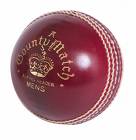
 |
| Index | ||||||
|
Ball, leather  1. A ball is another description for one of the deliveries in an over, as well as being... 2 .... the spherical, leather-covered object bowled by the bowler. The physical ball is subject to certain minimum and maximum weight and measurement limits - it must not weigh more than 5 3/4 oz (163g) or have a circumference greater than 9 inches (22.9 cm), for instance. There are smaller, lighter balls specified for junior and women's cricket. A cricket ball is not a perfect sphere. It has a raised seam, stitching the two halves of the leather covering together. Because it disturbs the flow of air round the ball as it is delivered, this seam, together with vigorous polishing of one side of the ball, and the pace at which the ball is bowled, can be used by the bowler to help impart movement on the delivery either before, after, or as it pitches. Clever use of the seam can thus be a key weapon in the bowler's armoury. The balls used in a match have to be approved by both umpires and captains before play and remain under the umpires' control until the match ends. If a ball is lost or something happens to it that renders it unfit for play the umpires should replace it with another that has had comparable wear. If the match is scheduled to last for more than one day the fielding captain may ask for a new ball after his side have bowled a stated number of overs. The number of overs will depend on the playing conditions of the match but should never be fewer than 75. Fielders are allowed to polish the ball, or dry or clean it under the supervision of the umpire, but changing the condition of the ball - commonly called ball tampering - is regarded as cheating - unfair play, specifically prohibited under the Preamble - Spirit of Cricket and elsewhere in the Laws of the game. | ||||||